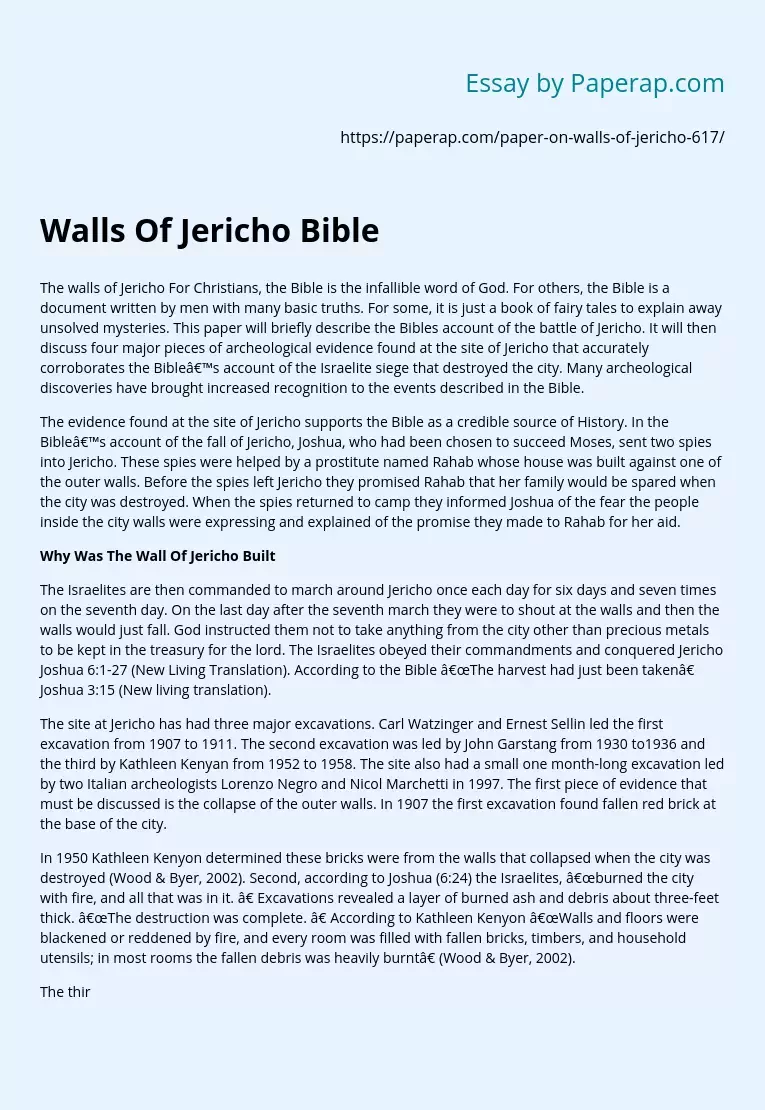Walls Of Jericho Bible
The walls of Jericho For Christians, the Bible is the infallible word of God. For others, the Bible is a document written by men with many basic truths. For some, it is just a book of fairy tales to explain away unsolved mysteries. This paper will briefly describe the Bibles account of the battle of Jericho. It will then discuss four major pieces of archeological evidence found at the site of Jericho that accurately corroborates the Bible’s account of the Israelite siege that destroyed the city.
Many archeological discoveries have brought increased recognition to the events described in the Bible.
The evidence found at the site of Jericho supports the Bible as a credible source of History. In the Bible’s account of the fall of Jericho, Joshua, who had been chosen to succeed Moses, sent two spies into Jericho. These spies were helped by a prostitute named Rahab whose house was built against one of the outer walls. Before the spies left Jericho they promised Rahab that her family would be spared when the city was destroyed.
When the spies returned to camp they informed Joshua of the fear the people inside the city walls were expressing and explained of the promise they made to Rahab for her aid.
Why Was The Wall Of Jericho Built
The Israelites are then commanded to march around Jericho once each day for six days and seven times on the seventh day. On the last day after the seventh march they were to shout at the walls and then the walls would just fall.
God instructed them not to take anything from the city other than precious metals to be kept in the treasury for the lord. The Israelites obeyed their commandments and conquered Jericho Joshua 6:1-27 (New Living Translation). According to the Bible “The harvest had just been taken” Joshua 3:15 (New living translation).
The site at Jericho has had three major excavations. Carl Watzinger and Ernest Sellin led the first excavation from 1907 to 1911. The second excavation was led by John Garstang from 1930 to1936 and the third by Kathleen Kenyan from 1952 to 1958. The site also had a small one month-long excavation led by two Italian archeologists Lorenzo Negro and Nicol Marchetti in 1997. The first piece of evidence that must be discussed is the collapse of the outer walls. In 1907 the first excavation found fallen red brick at the base of the city.
In 1950 Kathleen Kenyon determined these bricks were from the walls that collapsed when the city was destroyed (Wood & Byer, 2002). Second, according to Joshua (6:24) the Israelites, “burned the city with fire, and all that was in it. ” Excavations revealed a layer of burned ash and debris about three-feet thick. “The destruction was complete. ” According to Kathleen Kenyon “Walls and floors were blackened or reddened by fire, and every room was filled with fallen bricks, timbers, and household utensils; in most rooms the fallen debris was heavily burnt” (Wood & Byer, 2002).
The third piece of evidence found that corroborates the Bible is the full jars of grain found in the lower storage rooms in the homes of the city. Grain was valuable not only as a source of food but was also used as a commodity for sale or trade. ”The presence of these grains still in the destroyed city is entirely consistent with the biblical account,” Dr. Wood wrote . ”The city did not fall as a result of a starvation siege, as was so common in ancient times. Instead, the Bible tells us Jericho was destroyed after but seven days (Wilford, 2010). ‘ The Israelites were ordered not to take anything except precious metals, which would explain why the grain wasn’t taken. The last piece of evidence is the promise made to Rahab that her family would be spared. Rahab’s home was built against the outer wall. On the north side a short stretch of the lower city wall did not fall as everywhere else. A portion of that mud brick wall was still standing. What is more, there were houses built against the wall. In conclusion, the evidence found at the site of Jericho is consistent with the Bibles account of the city’s destruction. . The walls fell outwards as the Bible describes.
The city was burned as the Bible describes and the homes built against the only section of wall that did not fall suggest that Rahabs promise was kept. The archeological evidence found at the site of Jericho gives further proof of the historic accuracy of the Bible. References Wilford, J. N. (1990, February22,). Believers score in Battle over the Battle of Jericho. The New York Times. Retrieved from www. nytimes. com/1990/02/22/world/believers-score-in-battle-over-the-battle-of-jericho Wood, B. , & Byer, G. (2002). Is the Bible accurate concerning the destruction of walls of Jericho []. Retrieved from
Walls Of Jericho Bible. (2019, Dec 05). Retrieved from https://paperap.com/paper-on-walls-of-jericho-617/

